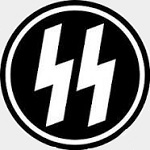Corgi US60204 German Sd. Kfz. 171 PzKpfw V Panther Ausf. A Medium Tank - SS-Oberscharfuhrer Ernst Barkmann, "Black 424", 4 Kompanie, SS Panzer Regiment 2, 2.SS Panzer Division, Normandy, July 1944 (1:50 Scale)
"If the tank succeeds, then victory follows."
- Major-General Heinz Guderian, "Achtung Panzer!"
 In many respects, the Panther tank was viewed as the finest armored fighting vehicle of the Second World War. Based in large part upon the Soviet's highly successful T-34 medium tank, the PzKpfw V Ausfuhrung G (Type G) was built by several manufacturers including MAN, Daimler-Benz, and MNH. Mounting a fearsome 7.5cm KwK42 L/70 cannon and two 7.92mm MG34 machineguns, the Panther Ausf. G represented the third and certainly the most impressive installment in the Panther series.
In many respects, the Panther tank was viewed as the finest armored fighting vehicle of the Second World War. Based in large part upon the Soviet's highly successful T-34 medium tank, the PzKpfw V Ausfuhrung G (Type G) was built by several manufacturers including MAN, Daimler-Benz, and MNH. Mounting a fearsome 7.5cm KwK42 L/70 cannon and two 7.92mm MG34 machineguns, the Panther Ausf. G represented the third and certainly the most impressive installment in the Panther series.
The weight of the production model was increased to 43 tons from the original plans for a 35 ton tank. Hitler had personally reviewed the final designs and insisted on an increase in the thickness of the frontal armor - the front glacis plate was increased from 60mm to 80mm and the turret front plate was increased from 80mm to 100mm.
Once the problems caused by the vulnerability of the engine and the transmission were solved, it proved to be a very effective fighting vehicle. The crew was made up of five members: driver, radio operator (who also fired the bow machine gun), gunner, loader, and commander.
Pictured here is a 1:50 scale replica of a German Sd. Kfz. 171 PzkPfw V Panther Ausf. A medium tank used by 4 Kompanie, SS Panzer Regiment 2, during the D-Day invasion.
Sold Out!
Dimensions:
Length: 5-1/2-inches
Width: 2-inches
Release Date: April 2004
 Historical Account: "Barkmann's Corner" - In July 1944, 2.SS Panzer Division ("Das Reich") was moved to Saint Lo to halt the US Army's advance, which was spearheaded by the 9th ("Old Reliables") and 30th ("Old Hickory") Infantry Divisions, as well as the 3rd Armored Division ("Spearhead"). On July 8th, SS-Unterscharfuher Ernst Barkmann's panzerkompanie was called upon to lead the counterattack, where he successfully destroyed a lone Sherman tank. Four days later, he smashed two more Shermans and disabled a third. Afterwards, Barkmann re-positioned his Panther for further fighting, destroying three more Shermans in the process.
Historical Account: "Barkmann's Corner" - In July 1944, 2.SS Panzer Division ("Das Reich") was moved to Saint Lo to halt the US Army's advance, which was spearheaded by the 9th ("Old Reliables") and 30th ("Old Hickory") Infantry Divisions, as well as the 3rd Armored Division ("Spearhead"). On July 8th, SS-Unterscharfuher Ernst Barkmann's panzerkompanie was called upon to lead the counterattack, where he successfully destroyed a lone Sherman tank. Four days later, he smashed two more Shermans and disabled a third. Afterwards, Barkmann re-positioned his Panther for further fighting, destroying three more Shermans in the process.
On July 27th, after undergoing repairs at a nearby field workshop, Barkmann discovered that his tank was cut off from the rest of his unit while attempting to rejoin his Kompanie. Near the village of Le Lorey, Barkmann was stopped by retreating German infantrymen who reported that a column of American armor was hot on their heels. After verifying the report, Barkmann's tank took up a position in the oak trees alongside a crossroad junction then lay in wait. When the American column approached, Barkmann's tank opened fire, knocking out the two leading tanks and a tanker truck. Two more Shermans attempted to circumvent the burning wreckage only to be knocked out in quick succession. After a low-level ground attack failed to dislodge the wiley Panther, the Americans sent in additional armor to end the threat once and for all. But Barkmann had other ideas. Over the course of the next hour, Barkmann and his crew would lay waste to another three Sherman tanks before withdrawing to the nearby village of Neufbourg. This engagement, oftentimes referred to as "Barkmann's Corner", would become one of the most memorable actions in the battle for Normandy.


